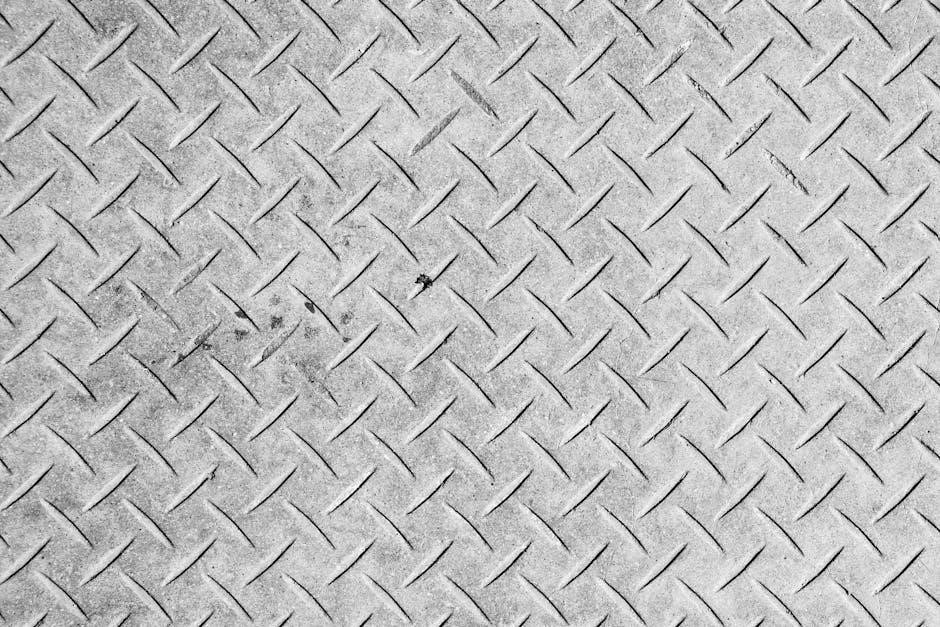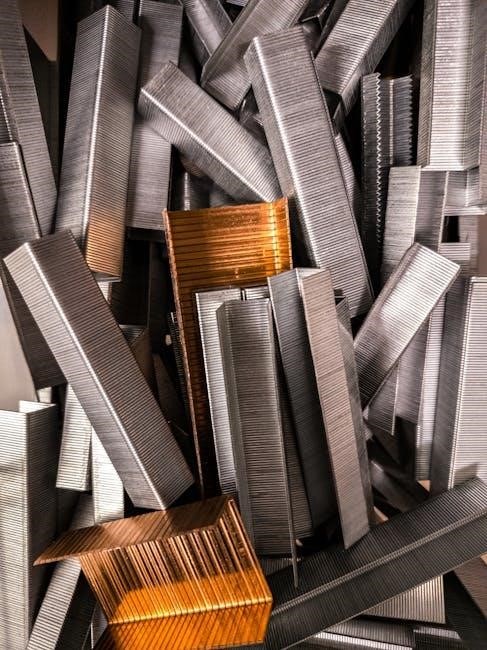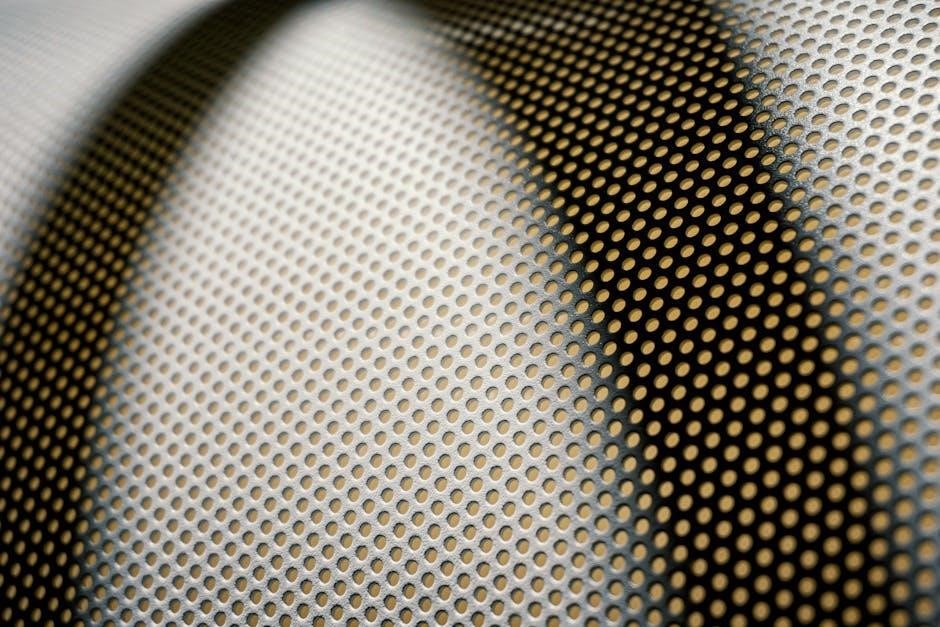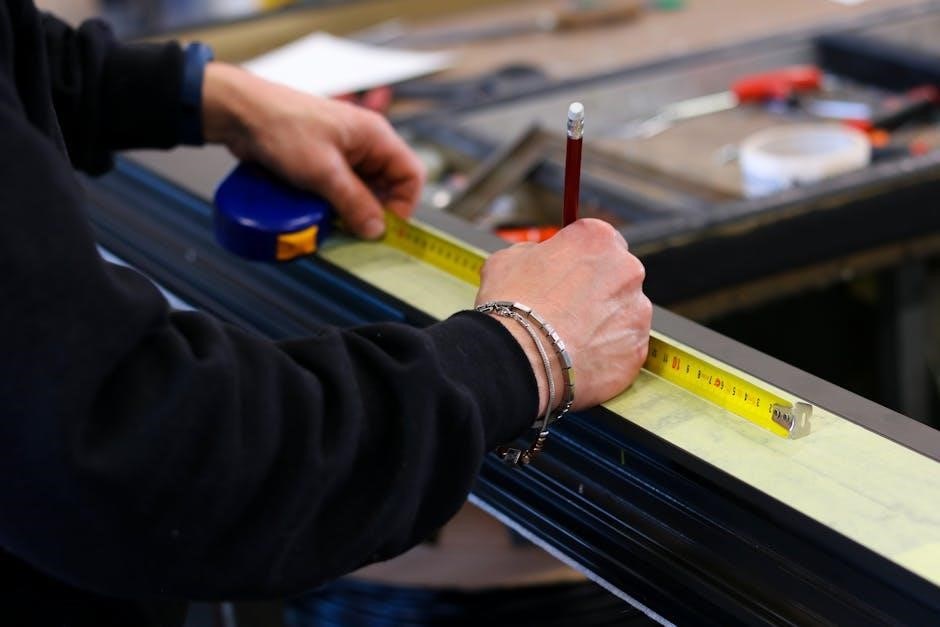7075-T6 aluminum is a high-strength alloy widely used in aerospace and defense due to its excellent mechanical properties and corrosion resistance‚ making it a critical material for demanding applications.
1.1 Overview of 7075-T6 Aluminum Alloy
7075-T6 aluminum alloy is a high-strength‚ lightweight material widely used in aerospace‚ defense‚ and high-performance applications. Known for its exceptional strength-to-weight ratio‚ it is heat-treatable and offers excellent mechanical properties. The T6 temper indicates that the alloy has been solution heat-treated and artificially aged‚ providing optimal strength and stability. Its chemical composition includes zinc as the primary alloying element‚ along with magnesium‚ copper‚ and chromium‚ which enhance its strength and corrosion resistance. With a density of approximately 2.81 g/cm³‚ it is ideal for applications where weight reduction is critical. Its combination of high tensile strength‚ toughness‚ and resistance to stress corrosion cracking makes it a preferred choice for aircraft structures‚ military equipment‚ and other demanding environments.
1.2 Importance of Material Properties in Engineering
Material properties are fundamental in engineering as they determine suitability for specific applications. Understanding properties like strength‚ durability‚ conductivity‚ and corrosion resistance ensures safety‚ efficiency‚ and reliability in designs. For 7075-T6 aluminum‚ its high tensile strength and corrosion resistance make it ideal for aerospace and defense. Engineers rely on material property data to select appropriate materials‚ optimize performance‚ and meet safety standards. Without accurate property data‚ designs may fail under stress or environmental exposure‚ leading to potential hazards and economic losses. Thus‚ detailed material property analysis is critical for innovation and problem-solving in engineering‚ enabling the creation of durable and high-performance products across industries.

Mechanical Properties of 7075-T6 Aluminum
7075-T6 aluminum exhibits exceptional strength-to-weight ratio‚ high durability‚ and resistance to stress‚ making it ideal for aerospace and defense applications requiring robust structural integrity and reliability.

2.1 Tensile Strength and Yield Strength
7075-T6 aluminum exhibits exceptional tensile strength‚ typically ranging from 530 to 570 MPa‚ and a yield strength of approximately 460 to 480 MPa. These properties make it ideal for high-stress applications. The T6 temper signifies an artificial aging process that enhances its mechanical performance‚ particularly in aerospace and engineering components. The combination of high tensile and yield strength ensures durability and resistance to deformation under load; This alloy’s strength-to-weight ratio is superior compared to other aluminum grades‚ making it a preferred choice for structural parts in aircraft and defense systems. Its ability to maintain strength at elevated temperatures further enhances its versatility in demanding environments.
2.2 Hardness and Elastic Modulus
The hardness of 7075-T6 aluminum is typically measured using the Brinell hardness test‚ yielding a value of around 150 HB. This indicates a high resistance to abrasion and wear‚ making it suitable for applications where surface durability is critical. The elastic modulus‚ or Young’s modulus‚ of 7075-T6 is approximately 70 GPa‚ which reflects its stiffness under load. This property is essential for maintaining structural integrity in components subjected to bending or torsional forces. Together‚ these properties contribute to the alloy’s excellent performance in demanding environments‚ balancing strength‚ durability‚ and resistance to deformation. These characteristics are well-documented in the 7075-T6 aluminum material properties PDF‚ providing engineers with reliable data for design and manufacturing processes.
2.3 Impact Resistance and Fatigue Strength
7075-T6 aluminum exhibits excellent impact resistance and fatigue strength‚ making it suitable for high-stress applications. Its ability to absorb energy without cracking under sudden loads is critical in aerospace and defense. Fatigue strength‚ measured by endurance limit‚ indicates the material’s resistance to failure under cyclic stress. For 7075-T6‚ the fatigue strength is approximately 160–200 MPa‚ depending on the application and environment. Surface finish‚ design‚ and manufacturing processes significantly influence these properties. The alloy’s high resistance to crack propagation ensures durability over time‚ even in harsh conditions. These characteristics are vital for components subjected to repetitive loading‚ such as aircraft parts and machinery. Proper heat treatment and surface finishing can further enhance these properties‚ ensuring long-term reliability and performance.

Physical Properties of 7075-T6 Aluminum
7075-T6 aluminum exhibits a density of approximately 2.81 g/cm³‚ high thermal conductivity‚ and moderate electrical conductivity‚ with a coefficient of thermal expansion of about 23.4 μm/m·°C and specific heat capacity of 840 J/kg·K.
3.1 Density and Specific Gravity
The density of 7075-T6 aluminum is approximately 2.81 g/cm³‚ making it significantly lighter than steel while maintaining high strength. Specific gravity‚ the ratio of the material’s density to water‚ is around 2.81‚ indicating its buoyancy relative to water. These properties are crucial for weight-sensitive applications‚ such as aircraft components‚ where minimizing mass without compromising performance is essential. The material’s low density contributes to its high strength-to-weight ratio‚ a key factor in its widespread use in aerospace and defense industries. Understanding these values helps engineers estimate material requirements and predict behavior in various environments‚ ensuring optimal design and functionality in critical applications.
3.2 Thermal Conductivity and Expansion
The 7075-T6 aluminum alloy exhibits moderate thermal conductivity‚ lower than pure aluminum due to its alloying elements‚ making it suitable for applications where heat transfer needs to be controlled. Its thermal expansion coefficient is higher than steel but lower than many plastics‚ ensuring dimensional stability over a range of temperatures. This balance makes it ideal for aerospace components exposed to varying thermal conditions. The material’s ability to maintain structural integrity under thermal stress is a key factor in its widespread use. Understanding these properties is crucial for designing components that operate efficiently in diverse environmental conditions without compromising performance or longevity.
3.3 Electrical Conductivity and Magnetic Properties
7075-T6 aluminum exhibits moderate electrical conductivity‚ approximately 30-40% that of pure copper‚ making it suitable for applications requiring reasonable electrical performance. Its magnetic properties are negligible‚ as aluminum is paramagnetic and not ferromagnetic. This makes it ideal for environments where magnetic interference is a concern. However‚ alloying elements like zinc and magnesium slightly reduce its electrical conductivity compared to pure aluminum. Despite this‚ the alloy’s high strength-to-weight ratio and resistance to corrosion often outweigh its moderate electrical performance in engineering applications. Engineers should consider these properties when designing components for electrical systems or high-frequency applications. Additionally‚ the material’s non-magnetic nature is advantageous in scenarios where magnetic fields could interfere with performance or safety.

Chemical Properties of 7075-T6 Aluminum
7075-T6 aluminum exhibits strong corrosion resistance due to its zinc content‚ with alloying elements enhancing its chemical stability‚ making it suitable for harsh environmental conditions and marine applications.
4.1 Corrosion Resistance and Reactivity
7075-T6 aluminum exhibits strong corrosion resistance due to its protective oxide layer‚ making it suitable for marine environments. Its resistance to seawater and stress-corrosion cracking is notable‚ though it may require coatings in highly corrosive settings. The alloy’s reactivity is low under normal conditions‚ but it can react with strong acids and bases‚ particularly when the oxide layer is compromised. Alloying elements like zinc and magnesium enhance its corrosion performance‚ while the T6 temper improves strength without significantly sacrificing corrosion resistance. This balance makes 7075-T6 ideal for applications where both durability and environmental resistance are critical. Proper surface treatments can further enhance its corrosion resistance in demanding conditions.
4.2 Chemical Composition and Alloying Elements
The chemical composition of 7075-T6 aluminum includes aluminum as the primary element‚ with significant additions of zinc (5.1-6.1%)‚ magnesium (2.1-2.9%)‚ and copper (1.2-2.0%). These alloying elements enhance its mechanical properties‚ particularly strength and corrosion resistance. Zinc is the primary strengthening agent‚ while magnesium improves ductility and resistance to stress-corrosion cracking. Copper contributes to the alloy’s ability to undergo precipitation hardening during the T6 heat treatment process. Small amounts of chromium (0.15-0.35%) and iron (0.15-0.5%) are also present to refine grain structure and improve weldability; The precise balance of these elements ensures the alloy’s high performance in demanding applications‚ making it a cornerstone in aerospace and defense industries.
4.3 Environmental and Chemical Compatibility
7075-T6 aluminum exhibits excellent environmental and chemical compatibility‚ making it suitable for harsh conditions. Its corrosion resistance is enhanced by the T6 temper‚ which minimizes galvanic corrosion risks. In marine environments‚ it performs well due to its resistance to seawater corrosion. Chemically‚ it is stable in neutral and alkaline conditions but can react with strong acids or bases. The alloy is also resistant to organic chemicals‚ making it ideal for storage and transportation applications. Proper surface treatments‚ such as anodizing‚ further enhance its environmental durability. This compatibility ensures its reliability in outdoor and industrial settings‚ reducing maintenance needs and extending service life. Its balanced chemical and environmental resistance makes it a versatile choice for diverse industries.
Applications of 7075-T6 Aluminum
7075-T6 aluminum is widely used in aerospace‚ defense‚ and sports equipment due to its high strength-to-weight ratio‚ corrosion resistance‚ and durability‚ making it ideal for critical applications.
5.1 Aerospace and Aviation Industry

The aerospace and aviation industry relies heavily on 7075-T6 aluminum due to its high strength-to-weight ratio‚ corrosion resistance‚ and durability. It is widely used in aircraft structural components‚ such as wing spars‚ fuselage parts‚ and engine components. The alloy’s ability to maintain its mechanical properties at high temperatures makes it ideal for demanding aviation applications. Additionally‚ its resistance to fatigue and stress corrosion cracking ensures long-term reliability in harsh environments. 7075-T6 is also used in helicopter components and spacecraft parts‚ where weight reduction and strength are critical. Its widespread adoption in aerospace underscores its importance as a lightweight‚ high-performance material for modern aviation technologies.
5.2 Defense and Military Applications
7075-T6 aluminum is extensively used in defense and military applications due to its high strength‚ durability‚ and resistance to corrosion. Its lightweight yet robust properties make it ideal for aircraft components‚ missile parts‚ and armored vehicles. The alloy is also used in marine hardware and military equipment exposed to harsh environments. Its ability to maintain structural integrity under stress makes it a preferred choice for critical defense systems. Additionally‚ the alloy’s resistance to seawater corrosion is crucial for naval applications. The high strength-to-weight ratio ensures efficient performance in lightweight military gear and equipment. Its reliability under extreme conditions aligns with the demanding requirements of modern defense technologies.
5.3 Sports Equipment and Consumer Goods
7075-T6 aluminum is widely used in sports equipment due to its high strength-to-weight ratio‚ corrosion resistance‚ and durability. It is commonly found in bicycle frames‚ golf club components‚ and tennis racquet frames‚ where lightweight and rigidity are critical. In consumer goods‚ this alloy is used in high-end products like camera housings‚ smartphone components‚ and premium cookware. Its excellent mechanical properties make it ideal for applications requiring both performance and aesthetics. The alloy’s ability to withstand harsh environments also makes it suitable for outdoor equipment‚ such as hiking gear and marine hardware. Its versatility and reliability ensure its continued demand in both recreational and everyday consumer products.

Manufacturing and Machining Considerations
Machining 7075-T6 requires sharp tools and proper cooling to avoid galling. Manufacturing processes must account for its high strength and potential for stress corrosion cracking during forming.
6.1 Machining and Forming Techniques
Machining 7075-T6 aluminum requires careful attention to tooling and techniques due to its high strength and hardness. Common methods include milling‚ turning‚ and drilling‚ often using carbide or diamond-coated tools to minimize wear. The material can be formed through processes like forging‚ rolling‚ or extrusion‚ with forging being a preferred method for complex shapes. Cold working is effective for sheet or plate forms‚ while hot working is used for thicker sections to prevent cracking. Proper cooling and lubrication are essential to avoid thermal damage and ensure precise tolerances. Post-machining stress relieving may be needed for parts subjected to high residual stresses‚ ensuring dimensional stability. These techniques highlight the alloy’s versatility in manufacturing high-performance components.
6.2 Welding and Joining Methods
Welding 7075-T6 aluminum requires careful consideration due to its high strength and alloying elements‚ which can make it challenging to join without compromising its mechanical properties. Common methods include MIG and TIG welding‚ but these processes can lead to localized softening and reduced tensile strength in the heat-affected zones. To mitigate this‚ post-weld heat treatment is often recommended to restore the material’s original properties. Additionally‚ alternative joining techniques such as mechanical fastening or adhesive bonding are frequently used‚ especially in critical applications like aerospace‚ where maintaining the alloy’s integrity is paramount. Proper surface preparation and precision are essential to ensure successful and durable joints.
6;3 Heat Treatment and Aging Processes
7075-T6 aluminum’s heat treatment involves solution heat treatment at high temperatures to dissolve alloying elements‚ followed by water quenching to retain a supersaturated solid solution. Artificial aging at a controlled temperature forms strengthening precipitates‚ enhancing strength and hardness. The two-step aging process is essential for achieving optimal material performance. Proper control of temperature and time ensures desired properties‚ while improper treatment can lead to reduced strength and potential failure. This process is critical for applications requiring high strength-to-weight ratios‚ making 7075-T6 a preferred choice in aerospace and defense industries where such properties are crucial for safety and performance.
Material Property Data Sheet
The 7075-T6 aluminum material properties PDF provides detailed technical specifications‚ including mechanical properties‚ thermal conductivity‚ and chemical resistance data‚ essential for engineering applications and material selection decisions.

7.1 How to Obtain the 7075-T6 Aluminum Material Properties PDF
To obtain the 7075-T6 aluminum material properties PDF‚ visit reputable sources like ASTM‚ SAE‚ or aluminum manufacturers’ websites. Use specific keywords in your search‚ such as “7075-T6 material properties PDF” or “aluminum alloy 7075-T6 datasheet‚” to find relevant documents. Many suppliers‚ such as Alcoa or Kaiser Aluminum‚ provide detailed PDFs for free. Additionally‚ technical libraries or engineering databases like MatWeb or Engineeringtoolbox may host these files. Always verify the source’s credibility to ensure accuracy. Once downloaded‚ review the PDF for sections on mechanical‚ physical‚ and chemical properties to ensure it meets your requirements. This document is essential for engineers and manufacturers needing precise data for design and application purposes.
7.2 Key Sections in the Material Properties PDF

The 7075-T6 aluminum material properties PDF typically includes sections on mechanical properties‚ physical properties‚ and chemical properties. These sections provide detailed data on tensile strength‚ yield strength‚ hardness‚ and elastic modulus‚ as well as density‚ thermal conductivity‚ and electrical conductivity. Additional sections may cover corrosion resistance‚ fatigue strength‚ and impact resistance‚ which are critical for engineering applications. The PDF also often includes information on manufacturing considerations‚ such as machining‚ welding‚ and heat treatment processes. Finally‚ it may provide application guidelines and environmental compatibility data‚ making it an essential resource for engineers and designers working with this alloy. Each section is designed to offer comprehensive insights into the material’s performance and suitability for specific uses.
7.3 Interpretation of Technical Data
Interpreting the technical data in the 7075-T6 aluminum material properties PDF requires understanding key metrics like tensile strength‚ yield strength‚ and elongation. These values indicate the material’s performance under stress and its ductility. Engineers often cross-reference these properties with application-specific requirements to ensure suitability. For instance‚ high tensile strength may be critical for aerospace components‚ while corrosion resistance is vital for marine applications. The data also includes thermal and electrical properties‚ essential for environments where temperature fluctuations or conductivity are factors. Proper interpretation involves analyzing how these properties interact in real-world scenarios‚ ensuring the material meets design and safety standards. This step is crucial for optimizing material selection and performance in various industries.
7075-T6 aluminum’s exceptional strength‚ durability‚ and corrosion resistance make it a vital material for aerospace‚ defense‚ and high-performance applications‚ ensuring its continued relevance in modern engineering.
8.1 Summary of Key Material Properties
7075-T6 aluminum exhibits exceptional mechanical properties‚ including high tensile strength (around 570 MPa)‚ yield strength (500 MPa)‚ and hardness (150 HB). Its elastic modulus is approximately 70 GPa‚ and it demonstrates good fatigue resistance. The alloy’s density is 2.81 g/cm³‚ and it has moderate thermal conductivity (116 W/m-K) and thermal expansion (23 × 10⁻⁶ /°C). Electrically‚ it offers fair conductivity (30% IACS) and is non-magnetic. Corrosion resistance is enhanced due to its aluminum-zinc-magnesium-copper composition‚ though it may require surface treatments in harsh environments. These properties make 7075-T6 ideal for high-performance applications in aerospace and defense‚ where strength-to-weight ratios and durability are critical. Its balanced combination of mechanical and physical attributes ensures reliability in demanding conditions.

8.2 Future Trends and Developments
Future trends for 7075-T6 aluminum involve advancements in manufacturing technologies‚ such as additive manufacturing and surface treatment innovations‚ to enhance its performance. Researchers are exploring new alloy combinations to improve corrosion resistance and strength. Additionally‚ there is a growing focus on sustainable production methods to reduce environmental impact. The development of hybrid materials‚ combining aluminum with other metals or composites‚ is expected to expand its applications. Advances in 3D printing could also enable complex geometries‚ reducing weight while maintaining structural integrity. Furthermore‚ ongoing research into nanostructured alloys and grain refinement techniques promises to unlock even higher strength-to-weight ratios. These developments will ensure 7075-T6 aluminum remains a critical material for aerospace‚ defense‚ and emerging industries like renewable energy.
References
For further details‚ refer to the bibliography‚ including technical journals‚ industry standards‚ and the 7075-T6 aluminum material properties PDF for comprehensive specifications and additional insights.
9.1 Bibliography and Further Reading
A comprehensive bibliography for 7075-T6 aluminum includes industry standards‚ technical papers‚ and manufacturer datasheets. Key references include ASTM B209 for sheet and plate‚ AMS 4045 for machining‚ and ISO 6361 for wrought aluminum alloys. Additional resources like “Aluminum: Properties and Physical Metallurgy” by J.E. Hatch and “Aerospace Materials and Applications” provide in-depth insights. For further reading‚ consult publications from the Aluminum Association‚ SAE International‚ and peer-reviewed journals focusing on materials science. These sources offer detailed technical data‚ application guidelines‚ and research findings essential for engineers and professionals working with 7075-T6 aluminum.
